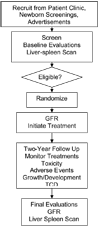The pediatric hydroxyurea phase III clinical trial (BABY HUG): challenges of study design
- PMID: 19731330
- PMCID: PMC2795081
- DOI: 10.1002/pbc.22269
The pediatric hydroxyurea phase III clinical trial (BABY HUG): challenges of study design
Abstract
Evidence of the laboratory benefits of hydroxyurea and its clinical efficacy in reducing acute vaso-occlusive events in adults and children with sickle cell anemia has accumulated for more than 15 years. A definitive clinical trial showing that hydroxyurea can also prevent organ damage might support widespread use of the drug at an early age. BABY HUG is a randomized, double-blind placebo-controlled trial to test whether treating young children ages 9-17 months at entry with a liquid preparation of hydroxyurea (20 mg/kg/day for 2 years) can decrease organ damage in the kidneys and spleen by at least 50%. Creation of BABY HUG entailed unique challenges and opportunities. Although protection of brain function might be considered a more compelling endpoint, preservation of spleen and renal function has clinical relevance, and significant treatment effects might be discernable within the mandated sample size of 200. Concerns about unanticipated severe toxicity and burdensome testing and monitoring requirements were addressed in part by an internal Feasibility and Safety Pilot Study, the successful completion of which was required prior to enrolling a larger number of children on the protocol. Concerns over recruitment of potentially vulnerable subjects were allayed by inclusion of a research subject advocate, or ombudsman. Finally, maintenance of blinding of research personnel was aided by inclusion of an unblinded primary endpoint person, charged with transmitting endpoint data and monitoring blood work locally for toxicity (ClinicalTrials.gov number, NCT00006400).
(c) 2009 Wiley-Liss, Inc.
Conflict of interest statement
The authors have no conflict of interest to declare.
Comment in
-
Hydroxurea and sickle cell disease: Its been a long, long time coming.Pediatr Blood Cancer. 2010 Feb;54(2):185-6. doi: 10.1002/pbc.22340. Pediatr Blood Cancer. 2010. PMID: 19908298 No abstract available.
References
-
- Platt OS, Thorington BD, Brambilla DJ, et al. Pain in sickle cell disease. Rates and risk factors. N Engl J Med. 1991;325:11–16. - PubMed
-
- Hebbel RP, Boogaerts MA, Eaton JW, Steinberg MH. Erythrocyte adherence to endothelium in sickle-cell anemia. A possible determinant of disease severity. N Engl J Med. 1980;302:992–995. - PubMed
-
- Hebbel RP, Schwartz RS, Mohandas N. The adhesive sickle erythrocyte: cause and consequence of abnormal interactions with endothelium, monocytes/macrophages and model membranes. Clin Haematol. 1985;14:141–161. - PubMed
Publication types
MeSH terms
Substances
Associated data
Grants and funding
LinkOut - more resources
Full Text Sources
Medical


